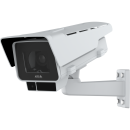
Round-trip investment.
Rio de Janeiro’s main airport adopts video monitoring system capable of supporting long-term operational improvements.
Mission
Rio de Janeiro is the largest tourist destination in Latin America and the entire Southern Hemisphere. The main point of arrival for tourists, whether they come from Europe, Africa, the Middle East or the rest of the Americas, is RIOgaleão. The concessionaire that took over its administration in 2014, was looking for a video monitoring system that could deal with their first major challenge—the 2016 Olympics—and provide long-term support for airport operations, which they will be responsible for until the end of the concession in 2039.
Solution
The integrator Ziva Tecnologia e Soluções proposed a video-monitoring project that over time could be developed into a smart tool to support airport management. Security in the airport’s sensitive areas has been enhanced by installing Axis IP cameras. High-quality surveillance images are now available for all sidewalks, baggage areas, x-ray control, and the container area and runway.
Covering a total area of 280,000 m2 — equivalent to 39 times the size of the soccer field at Rio’s Maracanã stadium—the airport is equipped with more than 820 Axis network cameras, including five P-line models, as well as AXIS Q1615-E from its Q line. All cameras are managed by SecurOS Enterprise software from Intelligent Security Systems (ISS), an Axis partner.
Result
With the images, the airport gained agility in responding not only to safety, but to the entire passenger experience inside RIOgaleão, from the sidewalk to the moment of takeoff. Each selected model met the requirements for each sector of the airport, which, in terms of area, is the largest in Brazil, and the country’s second busiest as well. The new system favored a high level of performance: the airport achieved the highest on-time rating in Latin America and was voted the fourth best airport in South America.

Safety is number one
The first part of the project focused on sensitive areas such as sidewalks, baggage control, x-ray control, the main passenger corridors and areas integrated into access control—another key aspect of the security plan. The other areas, monitored by the legacy cameras inherited from the previous administration, began to be replaced in a subsequent phase of the project.
Airport personnel use the images to identify suspects and to monitor movement within the limits of the Rio Galeão and in nearby outdoor areas. If necessary, the images can also help other security agencies, such as the federal police, army or bomb squad.
All of these areas are monitored using ISS software, from monitoring of the parking areas, to loading/ unloading sidewalks, access roads to the airport, cargo terminal, the Federal Revenue Service office, passenger boarding, aircraft movement, baggage carousels, to employee-only areas where the various access control devices are integrated into the software.
According to Alexandre Nastro, ISS country manager in Brazil, “RIOgaleão now has 100% image coverage for sensitive areas, and we are now working to transform these images into data for decision-making and better service delivery.”
The Olympic experience
In August 2016, Rio de Janeiro hosted the biggest sporting event on the planet. That month, the city received 450,000 foreign tourists. A good part of this audience arrived in the Marvelous City via RIOgaleão Airport. On its busiest day, there were no fewer than 85,000 passengers.
This period was the first major test of the new video monitoring system that the airport had adopted. After the practical test on security issues, airport administrators began to explore the system’s potential for other purposes.
4K on the runway
The use of the images has been expanded to support the passenger experience. “The cameras have been used in simple operations—like a passenger who has lost his parking ticket. We were able to follow the passenger’s path through the airport, where he passed by, and point out where he lost the ticket,” comments Datacenter Coordinator Bernardo Hoelz.

This process of improving operational flow, which helped find a parking ticket on the ground, is similar to the process adopted for safety purposes: operators in the control room detect a crowd forming inside the terminal and, thanks to the images, are able to mobilize the team for faster assistance. “The images are used by multiple areas of the airport, in addition to security,” says Antônio Nóbrega, IT and Telecom Infrastructure Manager.
One of these areas is traffic control. Currently, Axis cameras monitor aircraft take offs using four 4K cameras that transmit images to the control tower responsible for managing the 26 airlines that operate out of the airport: 5 domestic and 21 international. The very high resolution even allows the aircraft number to be read.
Low light levels? No problem.
The system tracks passengers even before they enter the airport facilities. AXIS P1365-E Network Cameras, equipped with Axis Lightfinder technology that yields color images even in the dark or under very low light conditions, were installed throughout the airport sidewalk area and in other low-light areas, such as the RIOgaleão container area, which is among the busiest cargo terminals in the country.

After testing the technology at the airport, and with encouraging results in terms of image quality, AXIS P1365-E cameras were installed throughout the airport sidewalk area and in other low-light areas, such as the RIOgaleão container area, which is among the busiest cargo terminals in the country.
“What led us to purchase cameras for the sidewalk area and other low-light locations was precisely Axis Lightfinder technology. Tests were conducted, and it is being used in specific spaces, “says Hoelz.
Cost-effective storage
Everything at RIOgaleão is superlative, including the volume of data trafficked over its network. Because of that, according to Bernardo Hoelz, one of the reasons for Axis’ favorable evaluation in the project is Axis Zipstream technology, which contributed to reducing the total cost of implementing the project.
“Zipstream was one of the points where Axis was rated highest, due to the large number of cameras we needed to purchase, with the possibility of cost-effective storage,” says the Datacenter Coordinator.
Axis Zipstream technology allows scenes with interesting details to be recorded in full image quality and resolution, while other areas are filtered to reduce bandwidth and storage usage by at least 50%.
Important forensic details such as faces, tattoos, or vehicle license plates are isolated and preserved, while irrelevant areas such as white walls, embankments, and vegetation are canceled out to provide more storage space, which leads to cost-effectiveness for the customer.
All the cameras we purchased for this project are Axis. We took the company’s best technologies into consideration for the project, and Axis Zipstream technology was one of the points where Axis was ranked the best.
Future-proof
By 2039, it is estimated that more than 80 million passengers will use the airport. This means another important factor for the project was its scalability and readiness for future developments. After all, the investment was made with the long-term in mind.
One of the examples of these possible developments is the measurement of vehicle flow and time of stay in certain areas, such as the loading/unloading zone, and the execution of analysis to predict when a congestion may happen, generating alerts so that staff responsible for traffic can respond proactively to the event.

Another example is integration of automation systems with images, allowing the video management system to interact with air conditioning systems, elevators, escalators, and lighting, activating these resources on demand according to the volume and movement of passengers inside from the airport. Facial recognition and other analytical technologies may also be adopted for restricted areas.
With the new cameras, the airport has built an environment suitable for the adoption of video analytics. “With this project, we are building the foundation to further explore the resources, but first we needed to get this environment working and to look at how we could benefit the most from the installation of video analytics,” concludes Antônio Nóbrega.
Products & solutions

Aviation
Our partner organizations
Get in touch
Want to know how you can benefit from Axis solutions? Get in touch and we will help you.
Contact us